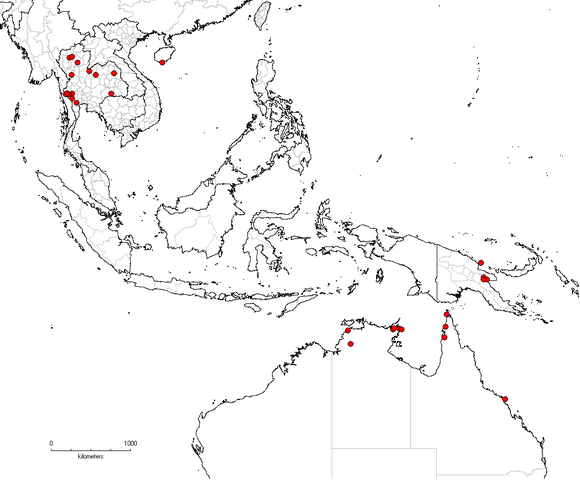Nomenclature
Merremia quinata (R. Br.) Ooststr., Fl. Males. ser. I, 4: 447. 1953.
Ipomoea quinata R.Br., Prodr. 486 (1810); Convolulus quinatus (R.Br.) Spreng., Syst. Veg., 1: 590 (1824).
Type: Australia. Northern Territory: North Coast. Island α [Mallison Island], 1 Mar. 1803, R. Brown [Bennett no. 2755]; holotype BM (photo BRI).
Convolvulus quinatus (R. Br.) Spreng.. Syst. 1: 590. 1825.
Ipomoea hirsuta R.Br., Prodr. 486 (1810); Convolvulus brownii Spreng., Syst. Veg., 1: 590 (1824) nom. illeg.
Type: Australia. Northern Territory: Arnhem, north Bay [Melville Bay], 14 Feb. 1803, R.Brown [Bennett no. 2756]; holotype BM (photo BRI).
Ipomoea pentadactylis Choisy, Mém. Soc. Phys. Genève 6: 471. 1834.
Description
Fang R.C., G. Staples, et al. 1995. Convolvulaceae in P. Raven & C.Y. Wu (eds.) Flora of China 16: 271–325.
Biogeography, Ecology and Natural History

China (Guangxi, Hainan, Hong Kong, Taiwan, Yunnan), Indonesia, Myanmar, New Guinea, Philippines, Thailand; Australia(Western Australia, Northern Territory, Queensland; also Malesia)
China: Open mountain slopes.
Thailand: Clearings, roadsides,
grassy places in dry dipterocarp forest, mixed deciduous forest,
fire-influenced dry forest, and rice paddies; altitude: 150–380 m.
Flowering: October, November; fruiting: November.
Fang R.C., G. Staples, et al. 1995. Convolvulaceae in P. Raven & C.Y. Wu (eds.) Flora of China 16: 271–325.
Other information
Ooststr. (Fl. Malesiana, ser. I., 4: 447. 1953) has expressed doubt that plants occurring in Myanmar, southern China, and southeast Asia are conspecific with those in New Guinea and Australia. We apply the name provisionally in a broad sense, pending consideration of the range of variation in populations throughout the region, and examination of type specimens for the names involved.
Authorship for webpage



Add new comment